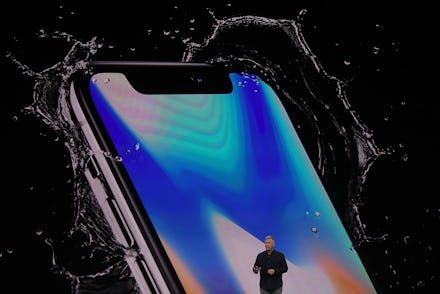Apple’s most revolutionary 2017 release is not the iPhone X

After a year of anticipation and rumors, the iPhone 8, 8 Plus and X were finally revealed at Apple’s 2017 keynote address on Tuesday in Cupertino, California. Although the iPhone X, released 10 years after the first iPhone, was clearly the star of the show, Apple’s most important new development isn’t a gadget at all — it’s augmented reality.
Put simply, augmented reality superimposes digital images into the world around us — just like in the game Pokémon Go. Thanks to ARKit, the platform that lets developers create AR experiences, augmented reality is in the people’s hands, and creators are having a blast with it.
Besides ARKit, which Apple unveiled in June, the iPhone X includes a bunch of features that will help augmented reality thrive, including the new A11 Bionic chip and a front-facing 3-D camera with a feature called Face ID. Say goodbye to TouchID; the iPhone X will use that camera and new 3-D facial recognition technology to unlock your phone. The new iPhone 8 and 8 Plus’ cameras are calibrated for AR with new gyroscopes, accelerometers and motion tracking, Apple announced.
For now, the new augmented reality technology baked into the iPhone X will mostly power fun and games. You’ll be able to make special, customized, animated emojis using your face called “animoji,” for example. Apple also demonstrated a Major League Baseball app that displays statistics over the real-life athletes, and a new augmented reality game called The Machines, a multiplayer shooter you play while looking through your iPhone.
Apple is slyly betting that augmented reality will be the future of our digital life. Tuesday’s event is the beginning of a trend that will change how you use your phone — and could someday replace it altogether.
The future of augmented reality
What could augmented reality bring us down the road? To find out, I called Justin Hendrix, executive director of NYC Media Lab.
“There’s an enormous amount of enthusiasm around ARKit,” Hendrix said. “We’re seeing it across a couple of different communities that we work with.” Those industries include entrepreneurship, media, education, health care and more.
In the next three to five years, we’ll likely see a lot more augmented reality, Hendrix said. “I think there’s going to be a lot of applications that people have only just begun to imagine.”
So there may be apps that allow you to take measurements of a real room or object using just your iPhone. There will be ways to totally edit the way you see the world around you. Eventually, we could see a wave of headsets and glasses (like Snapchat Spectacles and Google Glass) that will put the internet right in front of your eyes and into the real world.
Hendrix described one application of augmented reality in which surgeons use the technology to navigate MRI data. But he pointed out that augmented reality isn’t just for doctors and tech professionals. He compared it to YouTube in its ability to teach people new skills.
“Think about how YouTube changed the way we’ve learned to do little tasks. If I don’t know how to light the burner on my furnace, I can immediately go to YouTube, find a video, and I can teach myself very quickly how to do that. I think mobile AR is going to have a similar type of impact on the way we learn to do things and the way we engage.”
“Mobile AR is going to have a similar type of impact on the way we learn to do things and the way we engage.” — Justin Hendrix, NYC Media Lab
Developers have been working on augmented reality projects for decades, but Apple’s ARKit could change the game.
“We’re going to see the same explosion of creativity that we saw with the App Store, Hendrix said. “It’s a similar-scale opportunity. For a lot of developers, it’s an incredible moment.”